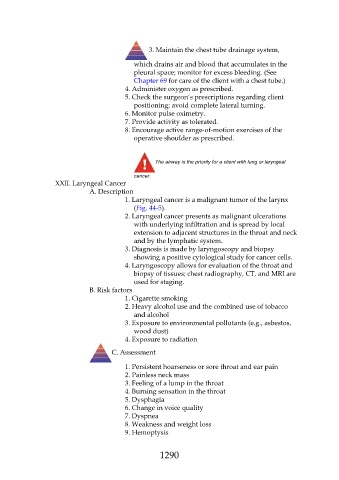Page 1290 - Saunders Comprehensive Review For NCLEX-RN
P. 1290
3. Maintain the chest tube drainage system,
which drains air and blood that accumulates in the
pleural space; monitor for excess bleeding. (See
Chapter 69 for care of the client with a chest tube.)
4. Administer oxygen as prescribed.
5. Check the surgeon’s prescriptions regarding client
positioning; avoid complete lateral turning.
6. Monitor pulse oximetry.
7. Provide activity as tolerated.
8. Encourage active range-of-motion exercises of the
operative shoulder as prescribed.
The airway is the priority for a client with lung or laryngeal
cancer.
XXII. Laryngeal Cancer
A. Description
1. Laryngeal cancer is a malignant tumor of the larynx
(Fig. 44-5).
2. Laryngeal cancer presents as malignant ulcerations
with underlying infiltration and is spread by local
extension to adjacent structures in the throat and neck
and by the lymphatic system.
3. Diagnosis is made by laryngoscopy and biopsy
showing a positive cytological study for cancer cells.
4. Laryngoscopy allows for evaluation of the throat and
biopsy of tissues; chest radiography, CT, and MRI are
used for staging.
B. Risk factors
1. Cigarette smoking
2. Heavy alcohol use and the combined use of tobacco
and alcohol
3. Exposure to environmental pollutants (e.g., asbestos,
wood dust)
4. Exposure to radiation
C. Assessment
1. Persistent hoarseness or sore throat and ear pain
2. Painless neck mass
3. Feeling of a lump in the throat
4. Burning sensation in the throat
5. Dysphagia
6. Change in voice quality
7. Dyspnea
8. Weakness and weight loss
9. Hemoptysis
1290

